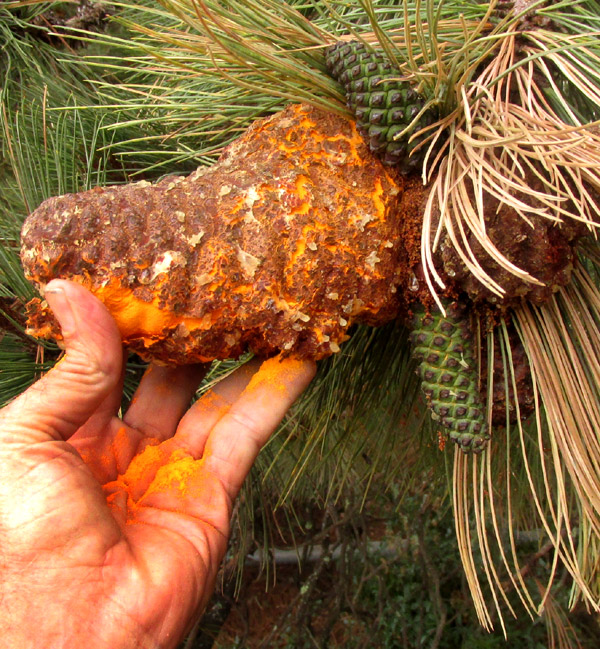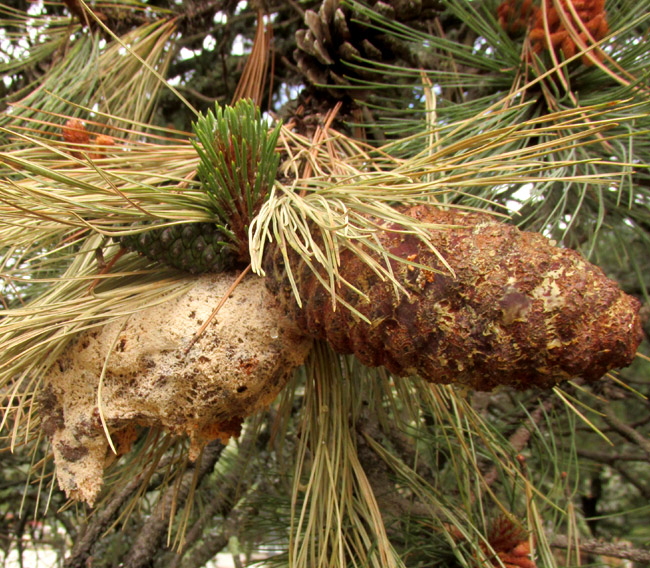Excerpts from Jim Conrad's
Naturalist Newsletter
Entry from field notes dated June 29, 2023, taken on valley slope forested with oaks and pines along road between Puerto del Zenthé and Chavarrías. That narrow road is attained by taking the very narrow, zigzagging road up the ridge rising on the southwestern side of Curva de la Doctorcilla, which is near km 18 on the branch road beginning at El Campamento and continuing to El Doctor, and which is numbered Hwy 120, though it branches off the main Hwy 120 running between San Juan del Río and Jalpan; at the road juncture atop the ridge, go south; limestone bedrock; elevation ~2400m (~7900 ft), Querétaro, MÉXICO, (N20.84890°, W99.60416°)
CONE RUST ON PINUS PSEUDOSTROBUS

Beside the road skirting the tiny community hosting a community kindergarten on the above-mentioned road, a relatively large pine tree, Pinus pseudostrobus, bore numerous cones infected with the fungal rust disease shown above. The infected, spore-producing, or sporulating, cone was much larger than uninfected mature cones. When cones are in this oversized, sporulating state, they're referred to as galls, and produce no seeds; the fungus takes over the cone and produces only spores. Note the orange spores on my hand. Two smaller, green, immature cones beside the gall stage appear uninfected, while a fourth cone, opposite the big one, seems to display an earlier stage of infection. Here's what other stages of the infection looks like:

The cone on the left was melting away, and disintegrated when touched.
On the Internet, by searching images showing rust diseases infecting pine cones, it was easy to find cones exhibiting the features seen above. The fungal organism causing this rust disease is CRONARTIUM CONIGENUM.
Cronartium conigenum is known in English as Southwestern Cone Rust, a name reflecting its occurrence in a small part of the southwestern US, where it attacks Chihuahuan Pines, Pinus chihuahuana. However, the fungus predominantly affects pines in the uplands of all of Mexico, south into Panama, so here we just call it Cone Rust.
The USDA's online Field Guide to Insects and Diseases of Arizona and New Mexico Forests, anonymously written and undated, says that the fungus produces spores both on pine cones -- which swell and are referred to as galls -- and another kind of spore produced on the undersides of oak leaves. On the oak host, the disease looks like brown to black wool on the leaves' lower surfaces.
The 2018 online publication by Claude Bragard and many others entitled "Pest categorisation of Cronartium spp. (non-EU)" lists five species of Mexican pines infected by Cronartium conigenum, of which Pinus pseudostrobu is one, as well as eight oak species. Of the oaks, in this area Quercus rugosa may be the prime host.
Bragard's publication also tells us that on the Chihuahuan Pine's infected cones, spores develop two to three years after infection. Also, at least on Chihuahuan Pines, large galls/cones such as those shown above usually kill the branches that bear them. On groups of Chihuahuan Pines, when weather is favorable for fungal development, more than half of all cones may be killed by the disease. I'm guessing that the disease causes similar effects on Mexico's trees.
The 2019 work by S.N. Wijesinghe and others entitled "The Genus Cronartium Revisited" describes a complex life cycle for Cronartium species. They write that "Most Cronartium spp. alternate between aecial (primary) host and telial (secondary) hosts." Aecial hosts are those producing a spore type known as aeciospores, in our case the infecting agent of our pine trees. The telial host -- here the oak species -- produces teliospores, which are thick-walled, resting states from which, when conditions are right, a basidium arises sexually producing basidiospores, which can infect more pine trees.
Details of the life cycle of Cronartium conigenum in Mexico haven't been well studied, and I can't find anyone describing what this specific fungus's complete life cycle is. Here's my impression of the basic cycle:
Sexual production of spores occurs on the undersurfaces of oak leaves; those spores infect pines, which asexually produce prodigious numbers of spores in their cones; those spores may infect both other pines and oaks, and; the cycle starts over after resting out the dry season in the oaks. Maybe pines can keep infecting one another more or less continually, but their spores are asexual, not contributing to the evolution of Cronartium conigenum. That job is done by the oak-produced spores.